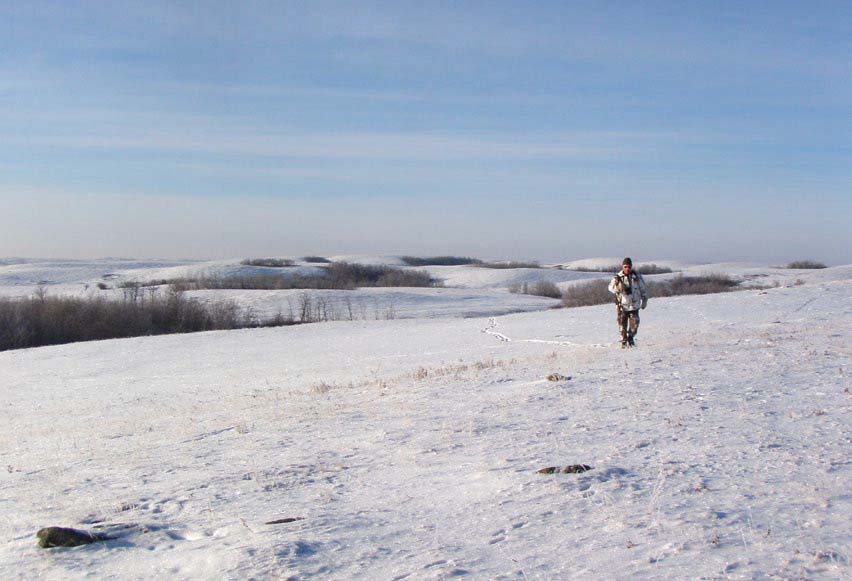When it’s –15C on the Canadian prairies, with a wind blowing out of the northeast, you must be prepared for bone-chilling hunts because your life depends on it!
I’ve developed a checklist that I use to gear up for such hunting conditions because it’s vitally important to be prepared for the worst weather, especially if you’re hunting some distance from home. Below zero temperatures with high wind chills could stretch for a week or more. There’s no going back home for something you’ve forgotten when you are hundreds of kilometres away from your residence.
It’s also very important to have light weight hunting apparel, not heavy, bulky clothing because hunters must be mobile. They must also be prepared to field dress a big game animal under brutal weather conditions.
Hypothermia And Frostbite
Legend has it that Canada’s Inuit understood the importance of dressing in layers with windproof outergarments to stay warm in sub-zero temperatures. Inuk also realized the danger of working up a sweat which could exacerbate the danger of hypothermia. Hypothermia occurs when a person’s body loses heat faster than it can generate it, causing a dangerously low body temperature that can result in death.
While being “cold” is a relative term, science dictates that the danger of frostbite increases with wind speed. Research indicate that once the wind chill makes the temperature feel like –28C or colder, exposed skin can freeze in under 30 minutes. When it drops to –40C, frostbite can occur in less than 10 minutes. Frostbite is a serious medical condition with localized damage to your skin from overexposure to cold temperatures. At temperatures below zero Celsius, a person’s blood vessels start to constrict and shunt blood from their extremities to preserve core body temperature. When that happens fingers, toes and a person’s face, in particular, can quickly freeze.
Checklist
People of different ages have different tolerances to weather while some might be better adapted to cold weather, so my checklist must be considered in that context.
- I wear a polyester base layer (top and bottom) that wicks sweat away when temperatures are near zero; I switch to a Marino wool undergarment base layer at -10C temperatures or lower. I also partake in the best heated hunting clothing for those exceedingly chilly days.
- I’m sold on Thinsulate™ which is a micro fabric made from synthetic fibers, woven together in various thicknesses, that helps keep you warm in sub zero temperatures. Thinsulate™ clothing is warm and lightweight, ideal for hunters.
- I wear light-weight winter boots that feature Thinsulate™ lining rated for -32C, have good ankle support and traction, other key features. I wear micro fleece pants at sub-zero temperatures but if there’s a significant wind chill I’ll switch to GORE-TEX lined pants, the ultimate for cold weather when matched with Marino wool undergarments.
- I wear Marino wool winter socks (not cotton) because they have cushioning and wicking fibers. If snow is more than ankle deep, I’ll put on gaiters to keep the snow out of my boots which will otherwise chill your feet when it melts. There are many thermal sweatshirts on the market that are ideal for subzero temperature. Depending on how cold it is, I’ll wear either a sleeveless and/or long-sleeved fleece liner vest, light and warm. A waterproof down vest is another option.
- I wear a hooded Thinsulate™ parka with storm cuffs that’s both light and warm made of fabric that’s quiet. I wear Thinsulate™ mittens and carry wool gloves with and without fingers that I’ll switch to for field dressing big game if it’s very cold. To keep my head warm, I wear either a micro-fiber toque or a Thinsulate™ hat depending on just how cold it is. I always pack a woollen balaclava for extremely cold weather which can be a deal breaker if there’s any amount of wind.
Summary
Hunters are especially susceptible to both frostbite and hypothermia simply because of the nature of hunting and the awful weather during many late season hunts. It’s common to walk long distances with a rifle and pack in the dark to be on point before daylight which can cause a person to sweat. Then, while on stand, as a person’s body cools off, body temperatures drop. Fingers and toes get cold. Often, hunters must remain still for long periods of time while on stand in sub-zero temperatures in pursuit of their quarry which makes matters even worse. You must be properly dressed or you should not even be hunting under such conditions.
By Duane Radford

